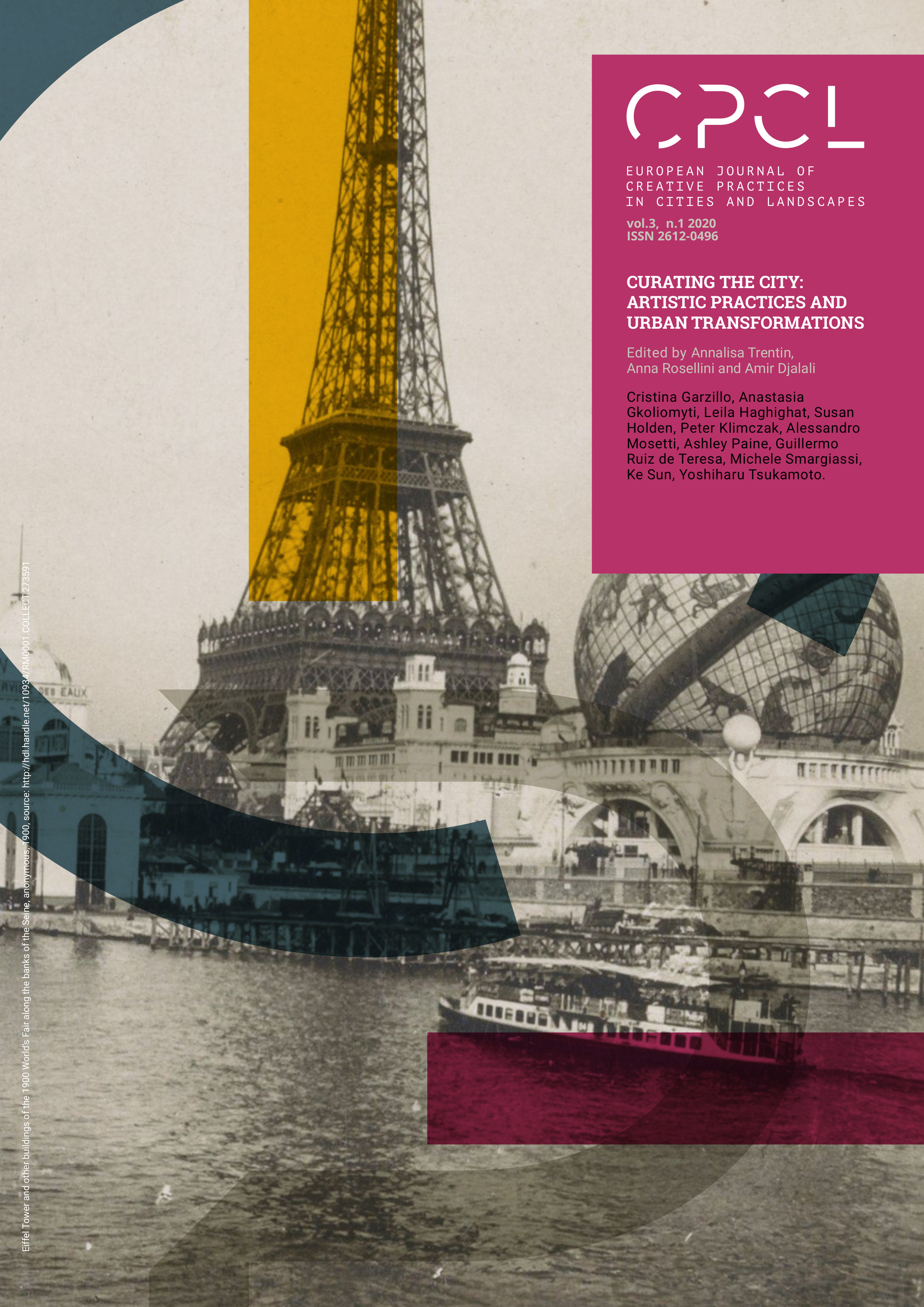Recognizing the Scenic Value of the City: Ephemeral Architecture as a Medium to Regenerate Urban Memories
DOI:
https://doi.org/10.6092/issn.2612-0496/10129Keywords:
strada novissima, venice biennale, ephemeral architecture, memory, scenic spaceAbstract
Today, we discuss “urban regeneration” often as the only way to revitalize those urban slices in the cities which has been forgotten or, somewhat, trivialized by consumer culture and tourism, which assault cities and tend to make them like an open-air playground. We should convey a process of “regeneration of collective memory” of the city through public exhibitions, as they were meant by the Venice Biennale or other cultural foundations rooted in cities during the ‘70s and ‘80s.
How can ephemeral architecture in the form of public exhibition help in this attempt?
Public exhibitions in the late ‘70s paved the way to a transparent methodology aimed at unifying both the Venetian and the international vocation of the Venice Biennale, against the prevalent tendency towards standardization of exhibitions.
This aspect, which is today absent, is one of the reasons why Venice is perceived as an open-air museum, rather than an active theatre for the collective memory.
The recovery, the study, and re-drawing this geography of non-existing places may offer a scenario of what it may be recovered in the future, as a methodology for future exhibitions, in order to cope with the danger of Venezia becoming a passive museum.
References
Argan, Giulio Carlo, and Christian Norberg-Schulz. Roma interrotta. Rome: Officina Edizioni, 1978.
Brusatin, Manlio. Venezia e lo spazio scenico. Venice: The Venice Biennale, 1980.
Camillo, Giulio. L’idea del theatro, edited by Lina Bolzoni. L’Italia 02. Palermo: Sellerio Editore, 1991.
Cattiodoro, Silvia. Architettura scenica e teatro urbano. Milan: FrancoAngeli, 2007.
Conte, Gian Biagio, Emilio Pianezzola, and Giuliano Ranucci. “Ephemerus.” In Il latino. Vocabolario della lingua latina, 461. Milan: Le Monnier, 2010.
Dal Co, Francesco. 10 immagini per Venezia. Rome: Officina edizioni, 1980.
D’Amato, Claudio. Studiare l’architettura: un vademecum e un dialogo. Rome: Gangemi, 2014.
Dezzi Bardeschi, Marco. “Venezia e lo spazio scenico.” Domus, no. 602 (1980): p. 8.
Ferlenga, Alberto. Aldo Rossi: tutte le opere. Milan: Electa, 2000.
Ferrucci, Fabio. L’arte della memoria di Giordano Bruno. Il trattato «De umbris idearum» rivisto dal noto esperto di scienza della memoria. Milan: Anima, 2005.
Fludd, Robert. Utriusque cosmi maioris scilicet et minoris metaphysica, physica atque technica historia. Oppenhemii: Hieronymi Galleri, 1617.
Guy, Michel, Giuseppe Galasso, Monique Mosser, and Paolo Portoghesi. L’après modernisme: la présence de l’histoire: Festival d’automne à Paris, La Biennal Di Venezia. Paris: L’Équerre, 1981.
Halbwachs, Maurice, and Lewis A. Coser. On Collective Memory. The Heritage of Sociology. Chicago: University of Chicago Press, 1992.
Lacan, Jacques. The Four Fundamental Concepts of Psychoanalysis. London: Routledge, 2018. https://doi.org/10.4324/9780429481826
Leoncilli Massi, Gian Carlo. “Il Sogno, La Favola, La Ragione e Il Reale: Temi per Due Progetti Veneziani.” La nuova città, no. 2 (1996): pp. 24–29.
———. La composizione commentari. Venice: Marsilio, 1986.
———. La leggenda del comporre. Florence: Alinea, 2002.
———. L’etrusco torna a scrivere. Florence: Alinea, 1997.
Leoncilli Massi, Gian Carlo, Giovanni Fraziano, Aldo Rossi. I labirinti, le piazze, le porte e i velari, i ponti, i palazzi, le case, i giardini: architetture di Giancarlo Leoncilli Massi: 6 February - 6 March 1988. Mantua: Casa del Mantegna, 1988.
Levy, Aaron, and William Menking. Architecture on Display: On the History of the Venice Biennale of Architecture. London: AA Publications, 2010.
Nicolini, Renato. Estate romana. Siena: Sisifo, 1991.
———. Estate romana: 1976-85: un effimero lungo nove anni. Reggio Calabria: Città del Sole, 2011.
Occhipinti, Chiara. Intorno ad aldo rossi e alla sua architettura. Milan: Politecnico di Milano, 2013.
Oswalt, Philipp, Klaus Overmeyer, and Philipp Misselwitz, eds. Urban Catalyst: the Power of Temporary Use. Berlin: DOM publishers, 2013.
Pelkonen, Eeva-Liisa, Carson Chan, and David Andrew Tasman, eds. Exhibiting Architecture: A Paradox? New Haven: Yale School of Architecture, 2015.
Portoghesi, Paolo. Terza Mostra Internazionale di Architettura: Progetto Venezia/The Venice Biennale. Venice: The Venice Bienniale, 1985.
Rossi, Aldo. Autobiografia scientifica. Nuovi Saggi. Parma: Pratiche Editrice, 1990.
———. “La Città Analoga.” Lotus, no. 13 (1976): pp. 4–7.
———. L’architettura della città. Padua: Marsilio, 1966.
Sartori, Donato, and Paola Pizzi. Maschere e mascheramenti. I Sartori tra arte e teatro. Padua: Il Poligrafo, 1996.
Serlio, Sebastiano. Tutte l’opere d’architettura di Sebastiano Serlio, Bolognese: dove si trattano in disegno, quelle cose, che sono più necessarie all’architetto. Venice: Francesco de Franceschi Senese, 1584.
Szacka, Léa-Catherine. Exhibiting the Postmodern: the 1980 Venice Architecture Biennale. Venice: Marsilio, 2016.
Tafuri, Manfredo. “Cecì n’est pas une ville.” Lotus, no. 13 (1976): pp. 8–10.
———. “L’éphémère est éternel: Aldo Rossi a Venezia.” Domus, no. 602 (1980): pp. 7–12.
Ventimiglia, Dario. Il carnevale del teatro. Venice: The Venice Biennale, 1984.
Yates, Frances A. The Art of Memory. Chicago: University of Chicago Press, 1966.
Zorzi, Ludovico. Il teatro e la città: saggi sulla scena italiana. Turin: Einaudi, 1977.
———. “Intorno Allo Spazio Scenico Veneziano.” In Venezia e lo spazio scenico, edited by Manlio Brusatin, pp. 81–109. Venice: The Venice Biennale, 1980.
Published
How to Cite
Issue
Section
License
Copyright (c) 2020 Alessandro Mosetti

This work is licensed under a Creative Commons Attribution 4.0 International License.




